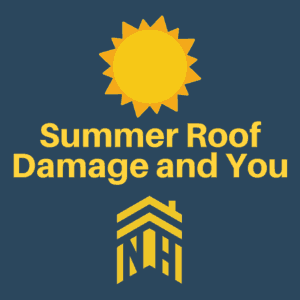
As we reach the hottest days of the summer months, your home is facing more and more abuse. You may not realize it, but these beautiful summer days can have their own risks for your home, just like the more obvious winter and fall seasons do.
Heat Damage - Summer heat will be one of the more inescapable forms of damage on your roof. Asphalt shingles in particular will be susceptible to heat damage, as the hot sun causes the asphalt to loosen and expand during the day. Once the sun sets, however, those shingles cool off quickly and contract. This expanding and contracting throughout the week slowly breaks down your shingles and can lead to cracking and loosening. This is of course worsened by the darker color of most asphalt shingle roofs. Darker colored material absorbs heat from the sun more efficiently, meaning that more heat builds up on the roof on a bright day. A dark asphalt shingle roof can easily get to 150 degrees Fahrenheit or more, and this extreme heat can cause lasting damage.
UV Damage - Probably the most inconspicuous source of summer damage for your roof is UV damage. Ultraviolet rays from the sun can break down the component materials inside your roof shingles. What’s more, these UV rays will penetrate below the surface of your roof shingles and slowly heat the moisture that’s absorbed both within your shingles and in some cases even your roof decking. Keep in mind, ultraviolet rays continue even on cloudy days, so even if your home isn’t being subjected to direct summer heat, this ultraviolet radiation is slowly but surely eating away at your roof throughout the summer.
Hail - While snow and sleet have thankfully left us behind, it is still possible to get ice damage on your roof even in the midst of summer! Hail storms can commonly strike even on hot summer days. At the extremely high altitudes where storm clouds form, air pressure and temperature drops far below what it is on the Earth’s surface. This allows water to stay in a frozen state, and can slowly build up into balls of hail. The water in most storm clouds is almost always frozen at these high temperatures, but normally melts as it passes through the warmer air closer to the ground, but in hail storms the denser balls of hail resist this melting and pea sized hail is fairly common. It’s not unheard of to get even larger balls of ice, golf ball or larger occasionally crop up. Regardless of the size of hail you get, hail storms can cause serious damage to your roof. Of course, hail is a serious risk that can cause damage to the rest of your home, which brings with it the additional risk that you won’t notice the damage to your roof as immediately as you record the rest of the damage on your property.
Summer certainly brings less risk than winter for your roof, but these factors do mean that your roof could still face damage. If your roof is newer and in good repair, you likely don’t have much to worry about, but if you have an older roof, these factors mean you still want to make sure you keep an eye on your roof’s condition throughout the year. If you suspect your roof does have issues, or you’d prefer the peace of mind of a professional opinion, call us today to schedule an inspection